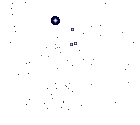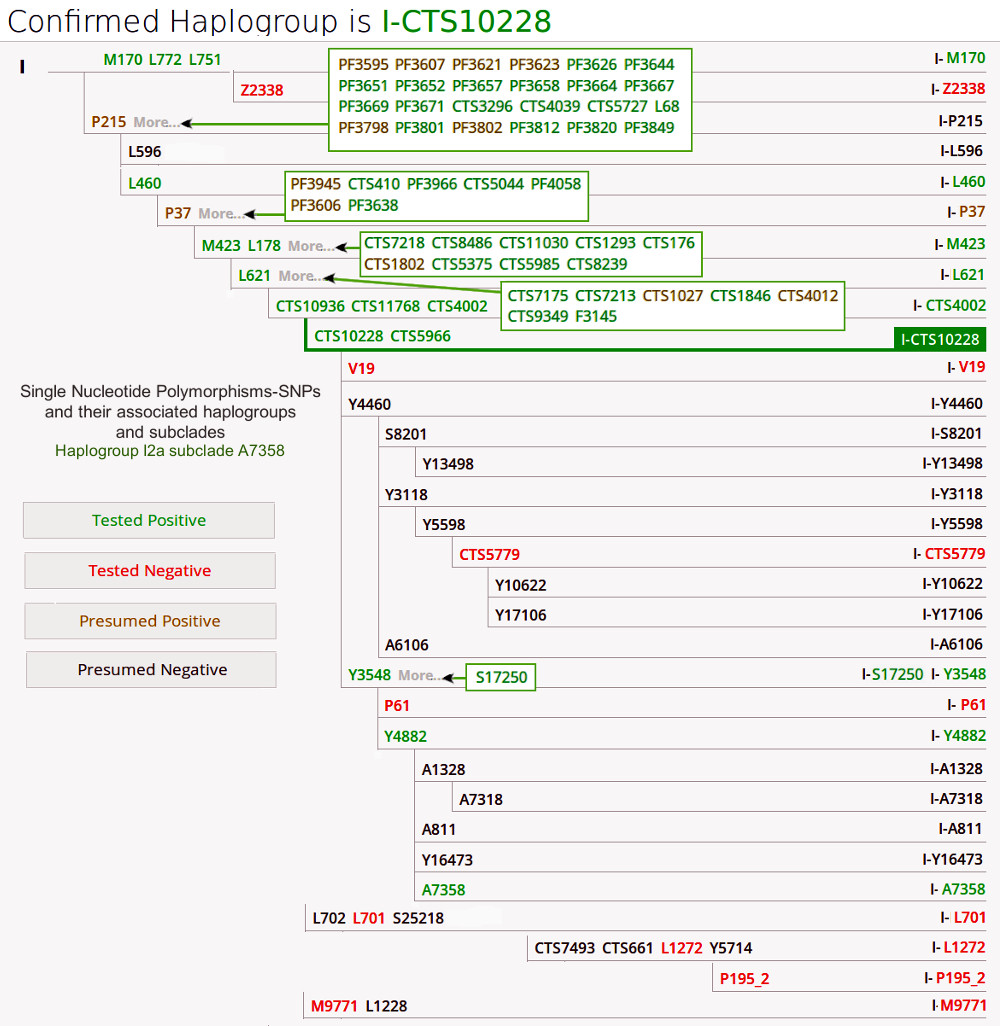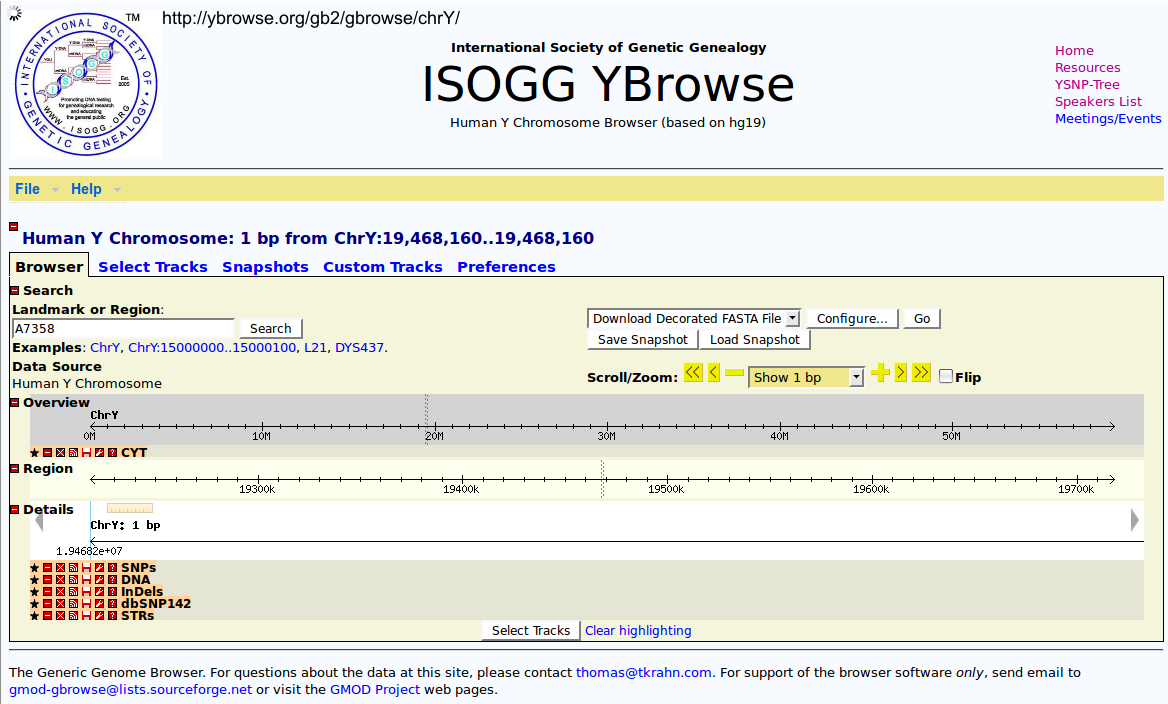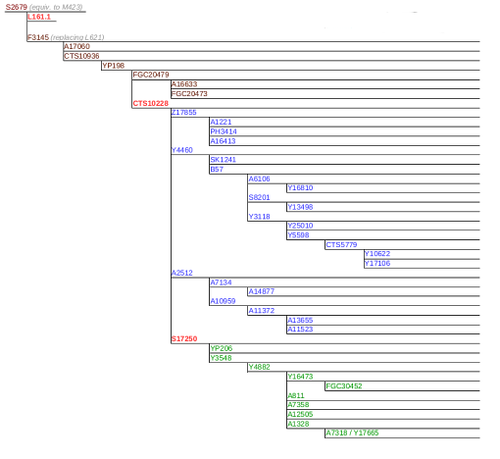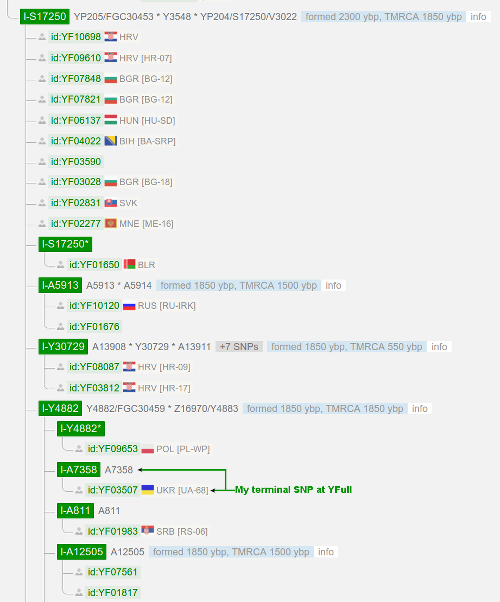~~* DNA Genetic Genealogy ~~*
~~* In Memory of My Mother and My Father ~~*
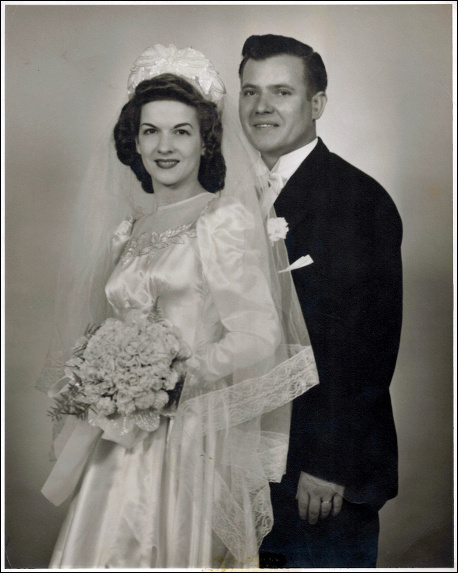
~~* Helen (Wlaż) and Stanley Petrowski (Petraszczuk) 1946 ~~*

~~* The Story of Finding My Tribe *~~
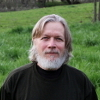
In 2015 I was contacted by a young man named Łukasz Kominko on face book. This started me on a journey of reconnecting with my family and ancestors in a way that I never would have imagined.
“Hello, My name is Luke and I live in Poland. For some time, I am looking for my grandfather's family. His aunt is Catherine Petrowski . She was born in Poland February 20, 1897 but later moved to the United States. Catherine's name before the wedding is KYC. She probably died on July 1, 1982 (Woodbury , Pennsylvania). Husband of Catherine's LUDWIG Petrowski. He also was born in Poland in 1897 and came to the United States in 1912. Wedding Catherine and Louis was in 1916. Catherine and Ludwig had 6 children: Stanley was born in 1918 , Kasmar was born in 1922, Joseph was born in 1924, Jenevive was born in 1921, Anna was born in 1929, in Marion Louise was born in 1936. Do you know someone in the family, or are you part of it? Best wishes and please help Luke Kominko”
I can not begin to express the joy and excitement that I felt as a result of this contact from Łukasz! On occasion I have searched the net, the records of Ellis Island ship manifests and the net just out of curiosity regarding my family roots. By and large records of various kinds can send you on wild goose chases because of the inevitable spelling and data errors. Ships manifests are notorious for this. I found the U.S. Census' really daunting. Nevertheless, I have managed to trace back my ancestry to my great and great great grandparents on both my paternal and maternal sides of the family and their places of birth in Poland and Ukraine. This is incredibly amazing to me since it is often very difficult to go that far back for many people. Wars and destructions have ravaged those lands. The things I have learned in this past year (2015) have eclipsed the level of understanding about my family far beyond my furthest dream.
This web space will be a record of the insights I have received of both my genetics research. I hope to do a thorough page regarding my family tree and genealogy discoveries also. In the mean time all updates to each topic will be included at the end of each topic section with a note as to the date of the update. I hope you enjoy the journey.
~~* DNA Testing Confirms Ancient and Deep Eastern European Roots *~~
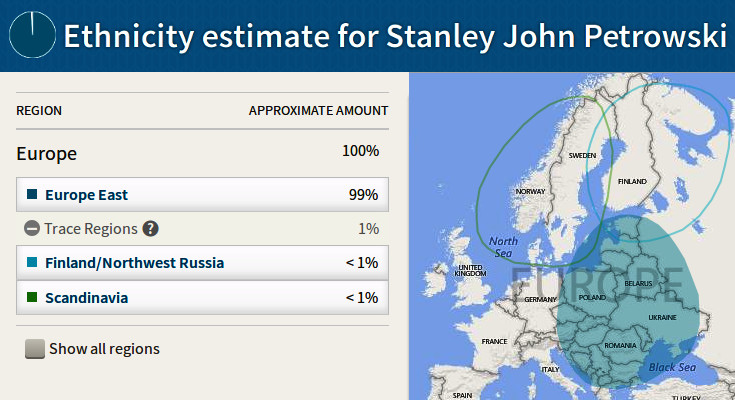
Ancestry DNA Autosomal DNA Ethnicity Results
AncestryDNA (ancestry) Test Results
Along with the amazing genealogy discoveries that could be traced by a "paper trail", my search inspired me to invest in an in depth DNA search. After doing research on line a strategy for DNA testing emerged that has been very helpful.
How can I begin to express the wonder I felt realizing what incredibly amazing creatures we are and how marvelous are the mysteries of our formation. One day after I had taken my DNA tests I became aware of a striking phenomena. We are dropping perfect miniature replications of ourselves all over the place! Encoded in our DNA is who we are. Your tears, saliva, hair and skin are falling all over the place. Within those cells are chromosomes that tell the present and ancient story of who you are. The color of your eyes, the color of your skin and many aspects of your health are all written down in material you scatter every time you shower, scratch your dandruff, sneeze, spit out a seed or scrape yourself on a rock. I haven't been afraid to share my DNA info for the simple reason that if anyone really wanted it they could get it pretty easily by following me around for a little while. Criminals are caught all the time by the DNA traces that they leave behind on tools, people and places.
There are several tests that can be done to examine various aspects of our DNA. Males can take three tests; Y-DNA, Autosomal DNA and Mitochondrial DNA. Woman can take two tests; autosomal DNA and Mitochondrial DNA. Y Chromosome DNA is passed from father to son only. Mitochondrial DNA is transmitted by mother to both sons and daughters. And finally our Autosomal DNA is made up of a "random" 50% of our chromosomal DNA from each parent.
There are several DNA testing companies out there. A review of these companies can be found at the International Society of Genetic Genealogy web site here: ISOGG Comparison Chart. I chose to test my autosomal DNA with ancestryDNA. The results from that company can be transfered to Family Tree DNA for a fee. This gives access to two data bases allowing for greater possible contact with relatives who have been tested.
Autosomal DNA (atDNA) reveals our ethnic make up. This image reveals the basic result from my ancestryDNA Autosomal test. It was difficult for me to accept these results. The average citizen of Poland is only 65% Eastern European. Poland has been conquered by many nations and ethnic groups. Turks, Tartars, Germans, Swedes, Prussians, Russians, Romans, French, Mongolian Hordes and other people groups have at one time or another taken possession of Eastern Europe. I carried none of these genetics according to ancestrydna. The margin of error is a possible 5% and even then it would have been a mixture of either Finnish or Norwegian admixture that would have been involved. You can see that my admixtures were estimated less than 1%.
I decided to test my autosomal DNA with another company in order to validate these results.
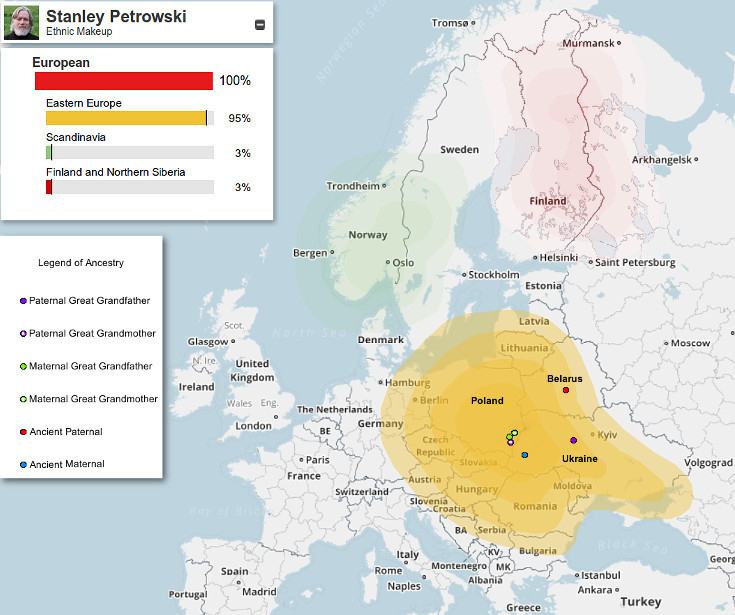
Family Tree DNA Autosomal Ethnicity Results
Family Tree DNA (ftdna) Test Results
Family Tree DNA is another company that does DNA testing. They are considered reputable. Another DNA sample was sent out to assess by autosomal DNA. This company also tests for Mitochondrial DNA (mtDNA) and Y Chromosome (YDNA). I will discuss those tests further along.
After much anxious waiting my test results returned. Much to my extreme surprise the data matched well within ancestry's margin of error. The image on the left pretty much says it all. 95% Eastern European, 3% Scandinavian and Finnish. Of course that makes me 101% Eastern European ;P . Located on the ftdna map also are the positions of known relatives and the most reliable record of ancient maternal and paternal DNA that could be related to me. All of these are right in the heart of the target area.
I would have been able to transfer my ancestry results to ftdna with confidence that the results were accurate.
What are the stories that surround the mystery of my very narrow ethnic make up? Perhaps someday I will know. It is a marvel that my maternal grandfather lived approximately three miles away from my paternal grandmother. How could they not have know each other? None of the conversations I recall mention this close proximity from the old country.
There is software freely available on line to test if you are inbred as far back as seven generations. Seeing the proximity of my ancestry I ran the data through only to find not a trace of that kind of mixture. You can see, I am sure, how I would really like to know just what happened to my ancient Slavic relatives. How did they become Christian? How did they survive being serfs? DNA may tells the story as archaeologists and anthropologists discover the remains of the peoples of these lands and test their genetics.
My life has been filled with much wandering all over the world. Because of that it strikes me odd to be see the multi generational confinement of my people to this one place on earth for so long a time. That being said, in a very abstract way, I feel very connected to Southern Poland and Western Ukraine. If it is possible I would very much like to take a trip to that land and those nations.
atDNA testing is one of the greatest tools genetic genealogists use to trace their family lines. More and more people are taking these tests. Some day perhaps I will meet cousins from other family lines to develop a greater picture of family history. Because the world population is always moving and changing we can say that the ethnicity predictions are very often educated guesses. Here's a great learning page regarding that subject: Identical by descent
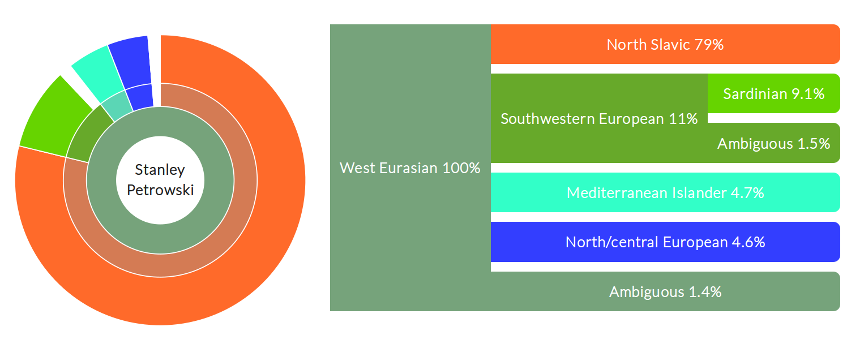
Ancestry Makeup According to DNA.LAND Algorithms
DNA.Land Ancestry Analysis
There is an online public autosomal/ancestry analysis site called DNA.Land. I'm not entirely impressed with the results but they are pretty close. The service is improving all the time and the data base is getting larger. This will, in time, become a valuable tool.
The ethnic group make up designations differ from both Ancestry DNA and Family Tree DNA. It seems to shift my ethnic origins toward "North Slavic" rather than Eastern European. Another peculiarity is that they almost entirely exclude me from Poland where I have traced my ancestral origins back 200 years via paper trail. They have me at 100% Western Eurasian which is a geological shift to the east of the other analysis sources.
Still, it's a neat tool that will improve as the data base and public input increases. It seems like a fast developing resource so I will update as improvements are made.
~~* Mitochondrial DNA - Inheritance From My Mother *~~
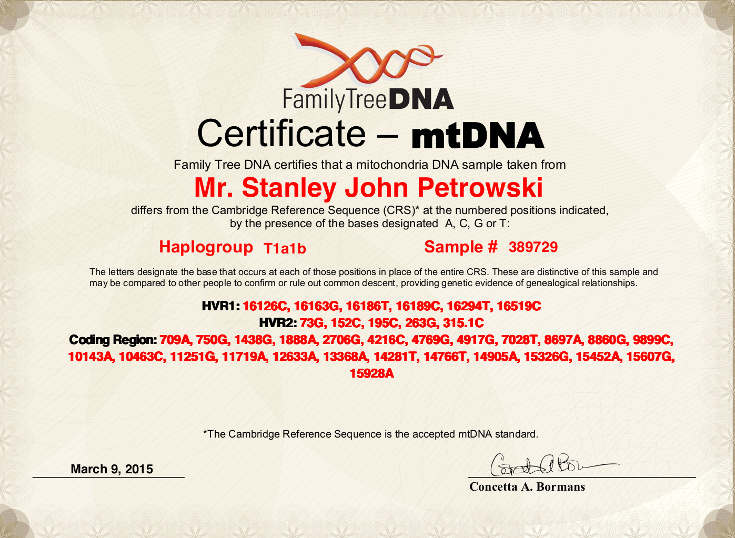
My Mother-Mitochondrial Haplogroup T1a1b
mtDNA
The next big investment in my genealogical search was a full mitochondrial DNA test. I opted for the full sequence mtDNA analysis through Family Tree DNA a company out of Texas, USA. This DNA is not found in the human cell nucleus like our chromosomes. Instead it is transmitted from mother to offspring through her mitochondria which are only transfered by females to their offspring. It seemed important to me to capture this data in memory of my dear mother. Through it the memory of her place in the human race will be remembered.
Mitochondrion (singular) is very ancient. The mutations that take place in it are far more infrequent than that which is found in chromosome markers such as the male Y chromosome. For that reason it is a very reliable indicator of ancient DNA and can be traced way back with greater certainty showing our maternal lines.
Mom carried the haplogroup T1a1b and gave it to me and my siblings. My sister then, will pass it along to her children.
If you are interested in learning more concerning mtDNA you can find a basic understanding of it here at wikipedia Mitochondrion or any of the numerous sites on line that are dedicated to teaching us what we need to know on this subject.
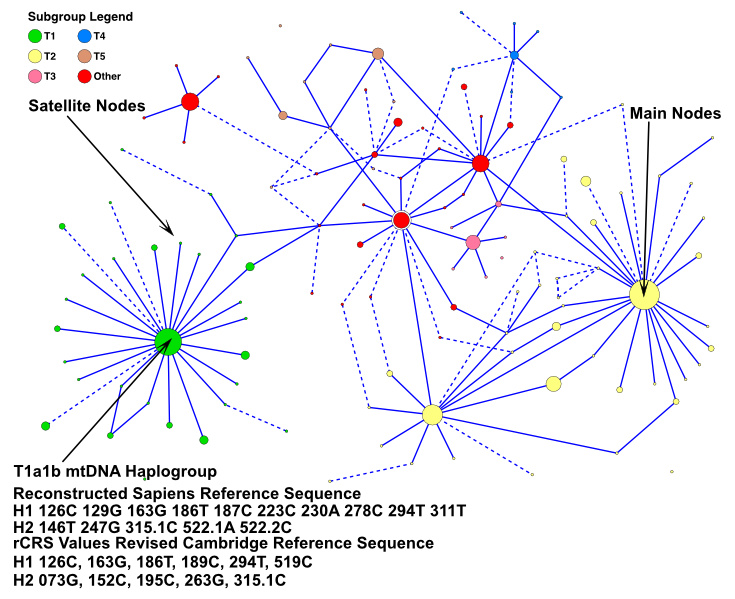
Phylogenetic Network of mtDNA T subclades. T1a1b is the subclade I inherited from my mother.
The Phylogenetic Network Map of Haplogroup T subclades
The phylogenetic network is a genetic map of mutations that have taken place over time in the human DNA tree. It depicts the relationship of those mutations one to another. Various styles of these maps can be found but they all declare that we are all cousins. We have grown genetically distant with many over time. So much so that our genetics hardly compare in specific areas of our DNA makeup. On the other hand there are ancient connections with near relatives that can often plainly be seen. Genetic genealogists use these DNA markers in attempts to discover relatives. This phylogenetic network map shows some of the distinct relationships and unique mitochondrial DNA mutations of haplogroup T subclades.
This particular map and an explanation of its characteristics is derived from a page produced by PhD David A. Pike of Memorial University of Newfoundland. I highly recommend it if you are interested in a greater depth of understanding how this mtDNA network has been mapped. Dr. Pike's page can be found here.
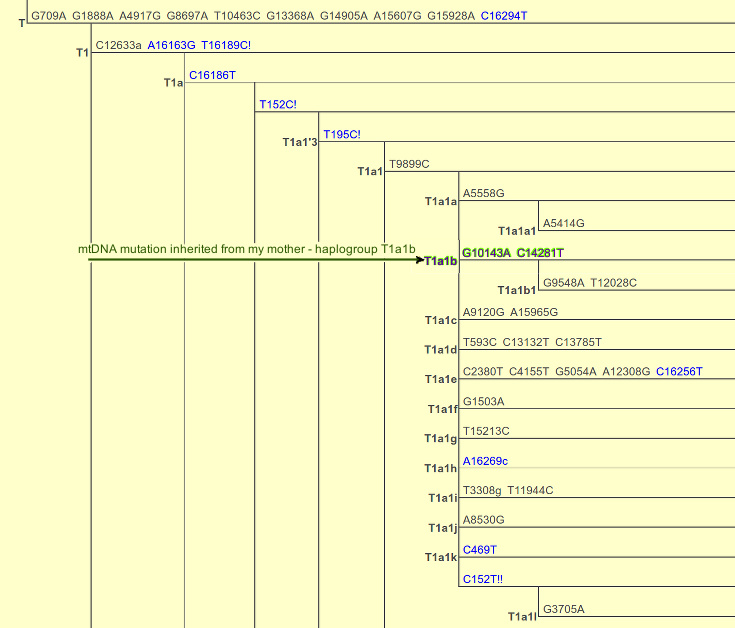
Phylogenetic Network of mtDNA T subclades. T1a1b is the subclade I inherited from my mother.
The Phylogenetic Tree of Haplogroup T-T1a subclades
Another method of expressing the relationships of the various mutations of mitochondrial DNA is illustrated here in a small segment of the overall "tree" of mtDNA. Here you can see specifically the mtDNA mutations the we are aware of to date. These phylogenetic trees change over time as more individuals are tested.
The full scope of the tree is very large and begins with an individual woman who is named Eve by geneticists. You can review it at http://www.phylotree.org/tree/main.htm. To navigate to the T haplogroup you must go the the R* clade and scroll down to the T clade to review T and its subclades.
If you would like to see the entire mtDNA phylogeny in PDF format it can be found at http://www.mitomap.org/pub/MITOMAP/MitomapFigures/mitomap-phylogeny.pdf. It's huge file loaded with data if you interested in getting a little geeky about mtDNA. On the other hand a simplified form can he found at http://www.mitomap.org/pub/MITOMAP/MitomapFigures/simple-tree-mitomap-2012.pdf
The business of tracking loose ends of research discoveries is phenomenal. There are so many trails to travel in our understanding of the science of genetics and the discovery of our place in the scope of humane race that it can be daunting. For now I am content with this level of knowledge regarding the mtDNA of my family. There is no doubt much more to discover about the genealogical aspects of mtDNA but for now I have been focused on my Y Chromosome. There's more to come as new discoveries are made.
~~* Y Journey - A Path in Search of My Paternal Ancestors-A Gift From My Father *~~
My Y Chromosome Discoveries
My First YDNA Test - STRs and SNPs
There's a lot of jargon associated with genetic genealogy. Most of it comes from the scientific community and has been assimilated by the genetic geneaology research community. Don't let this new vocabulary scare you away. Fortunately for us there are a lot of very helpful folks online that have made understanding this new culture and its lingo pretty easy. There are many thousands of individuals involved in searching out their roots as an interesting pass time. They help each other. There are also many individuals from the scientific community who are studying this fascinating subject. They do a lot to help us because we are contributing to their understanding of genetics by sharing our unique stories and the stories our DNA tells.
When dealing with paternal lineages inherited by your father, you mainly address the secrets hidden in your Y Chromosome. Only males have a Y chromosome. There are two aspects of the Y Chromosome that are analyzed with DNA testing. One is called our Short Tandem Repeats ( STRs ) and the other is called our Single Nucleotide Polymorphisms ( SNPs ). A reasonable explanation of these unique molecular characteristics can be found here: STRs vs SNPs, Multiple DNA Personalities. There are regions on our DNA that have unique markers of repeated sequences of specific molecules that make up our Y DNA. These areas help us know the haplotype (genetic pool type) that males received from their fathers. Because it is located on the Y Chromosome it is only carried by males and transmitted to male offspring from father to son. Over time there are mutations that take place in these areas and by analyzing these changes we can discover where we are genetically located in the male genetic groups (haplotypes) in humanities genetic tree of male lineages. It really isn't that complicated and I highly recommend you start gaining your understanding of this incredible aspect of your human makeup.
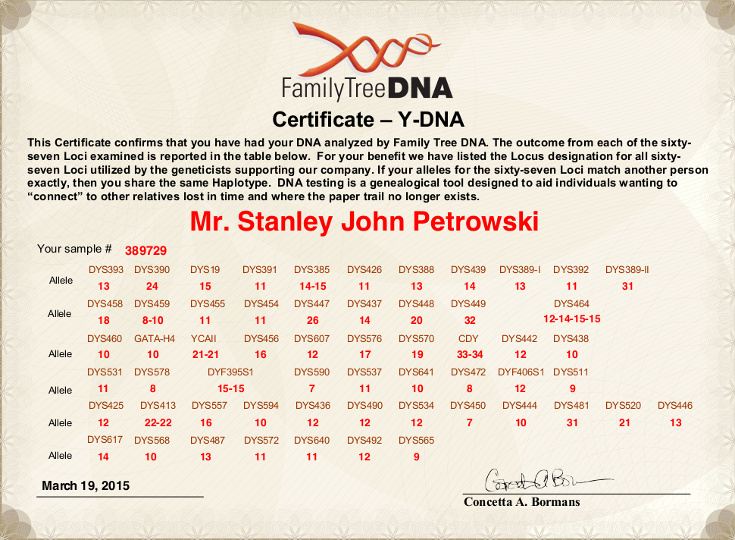
My STR Certificate showing my Short Tandem Repeats (STRs)
STRs
DNA testing takes a lot of patience. There is a veritable "tsunami" of DNA testing going on. It is much cheaper now than years ago and there is a huge up-swell of interest in genetic genealogy. Looking with hindsight, it was worth the wait and the cost.
The first Y test I took was from Family Tree DNA. I opted for the Y-DNA 67 test. I'm glad I did. If you start with less markers you can always "upgrade" your evaluation if you like. The more markers you have tested the easier it will be for you to find more accurate matches from the available data bases. The end result of my Y-67 test was this certificate on the left.
Individuals with this set of STRs have unique markers associated with a haplogroup I2a "Dinaric North". More on that latter.
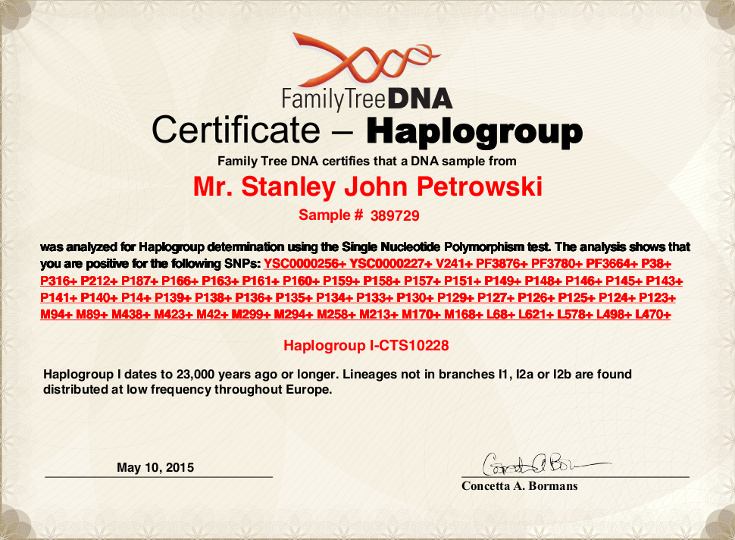
My SNP Certicate showing my Single Nucleotide Polymorphisms (SNPs)
SNPs
Single Nucleotide Polymorphisms are another layer of uniqueness in our DNA. If STRs are repeats of a pattern in our chromosome strand then SNPs are the unique configurations of our DNA molecules along those strands. This feature of our DNA pinpoints our place in the groups of males in the male genetics of the human race.
The initial test indicated that I was part of haplogroup I-P37. That was very helpful and brought me to an understanding of the place that science has estimated that I stand in the Y Chromosome tree of the human race. And though the information of human genetics is continually being updated the general "place" relationally to the Y haplogroup tree will remain the same. I was encouraged to test for a particular SNP by one of the genetic genealogy groups I belong to. The SNP marker is S17250, also known as YP204. I tested with a company called YSEQ for this single SNP. It was very affordable. This test returned a S17250+, meaning that the mutation was confirmed. The results from YSEQ established that I was most likely of the haplogroup subclade of I2a-CTS5966 (I-CTS10228).
After considerable deliberation I decided to make the investment to do ftDNA's Big-Y test. It is a comprehensive examination of the Y chromosome. It's expensive but I thought that it would contribute to a greater understanding of my paternal lineages and its origins. There also was the strong possibility that this data would contribute to citizen science.
The information related to DNA testing and its results are being updated all the time. In 2015 over a million people were dna tested so the data bases are quickly being populated. There are discoveries of ancient preserved human DNA being made on a regular basis also. Since my main haplogroup is haplogroup "I" and my main subbranch is I2a, I was interested in this 2015 genetic discovery for instance: Upper Paleolithic Genomes. In this case 4 ancient individuals were discovered in caves. Three in the Caucuses mountains and one of them, from Switzerland. The man from Switzerland was of haplogroup I2a. This illustrates the fact that haplogroup I and its subclades were some of the first inhabitants of Europe. Very cool. Now I know why I feel so old :) .
To illustrate these facts I include here a visual of the Y haplogroup tree. It represents the main branches found here: ISOGG_YDNATreeTrunk
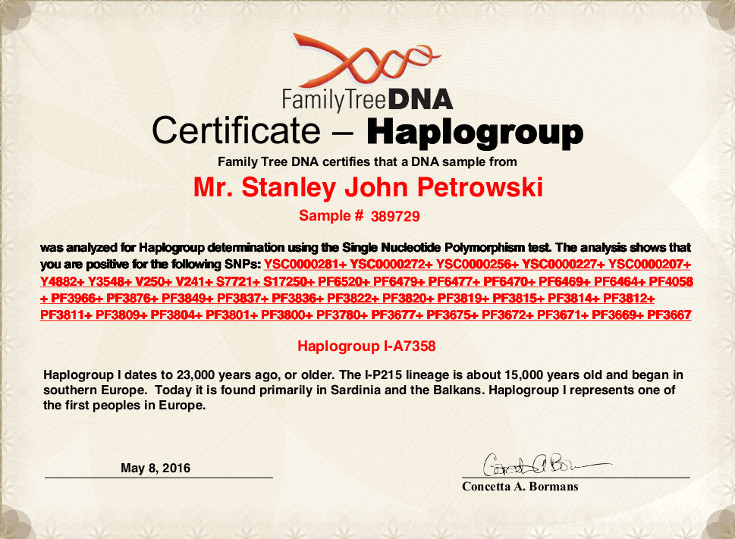
Updated SNP Certicate showing my new terminal SNP
Updated SNP Certificate
The more that people Big Y the more likely ISOGG will acknowledge this new branch on the human Y Chromosome tree.
So the short version of my testing and its associated revelations goes something like this.
| Test | Results |
|---|---|
| FTDNA Y67 Test (Y Chromosome 67 STR Test) | Haplogroup I "Presumed Positive" Subclade I-P37 |
| Full mtDNA Test (Full Sequence Mitochondrial DNA Test) | Haplogroup T Subclade T1a1b |
| FTDNA Family Finder (Autosomal DNA Test) | 95+/- % Eastern European Ethnicity |
| AncestryDNA (Autosomal DNA Test) | 99+/- % Eastern European Ethnicity |
| YSEQ Individual SNP Test for S17250 | SNP S17250+ Positive Subclade I-CTS10228 |
| FTDNA Big Y Test | Positive Subclade I-CTS10228 |
| YFull Full Service BigY Test Y Chromosome Analysis | Positive Subclade I-Y4882*, 34 Novel SNPs, 91 Private STR Mutations |
| FTDNA BigY Test Y Chromosome Analysis | Updated Terminal Subclade to I-A7358 |
As you can see the SNPs help decide the haplogroup and its subclades. They also help define what our terminal subclade is. The terminal subclade is the last branch of the tree that is commonly recognized by various organizations and must be shared with others to be valid. It can get confusing when various authoritative organizations and groups use different rules and names to group these branches. Below are the different groups I am a part of at ftDNA and how they define tree branch.
There are indications that a new subclade has been discovered to which I am related. There is a mutation at 19468160 which has now been named A7358. I know of someone who shares this mutation but he has chosen not to make his information public. Nevertheless there should be other carriers of this mutation and I am hopeful that one of them will be tested some day soon. The test for this individual subclade is inexpensive and can be found at the YSEQ.Net lab here.
| FTDNA Project Group | Subclade Path |
|---|---|
| Polish Group | I-P37 : M423+ CTS10936+ CTS5966+ S17250+ Y4882+ A7358+ (updated 03/06/2016) |
| I2a Y-Haplogroup I2a2 'Dinaric' | L621 > CTS10228 > S17250 > Y4882 > A7358 |
| Ukrainian DNA | [UA] I2a1b [M170+ M438+ L460+ P37.2+ M423+ L621+ CTS4002+ L147.2|CTS10228|CTS5966+ S17250|YP204+ Y3548+ Y4882+ A7358+] (updated 04/07/2016) |
| Baltic Sea Group | I2a1b2a1a2 L621 > CTS10228 > S17250 > Y4882 > A7358 |
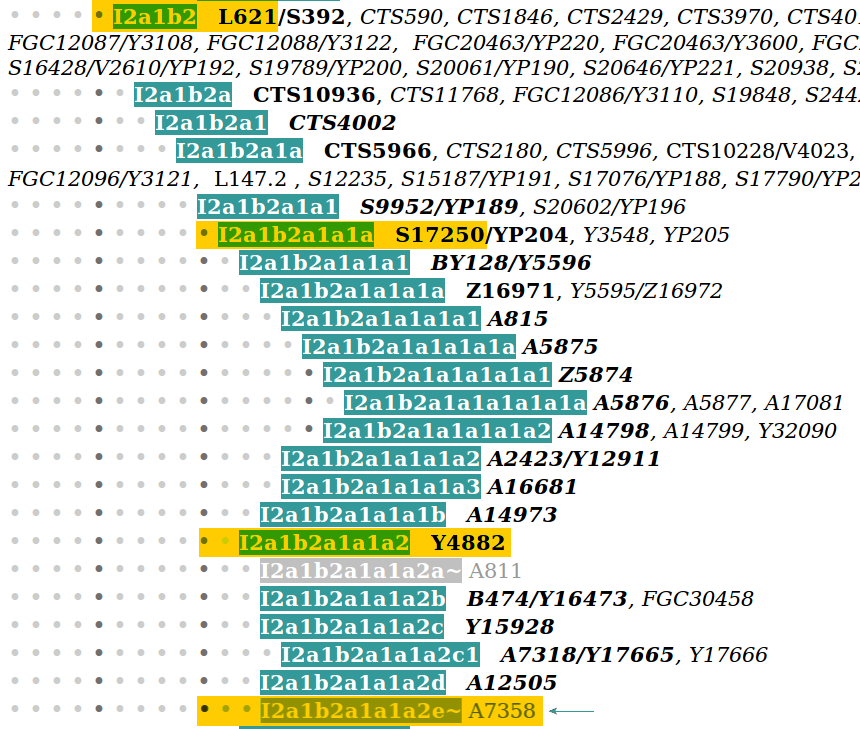
ISOGG Clade Path-updated 01/21/2018
I will post here periodically as I learn more. I especially want to thank Andrii Lundiak for inspiring me to put this web page together. I would also like to thank Krzysztof Narogfor putting together this awesome kml file and map related to SNP L621 and subclades. Click this link to see it:Krzysztof Narog's haplogroup map
I plan to eventually do a genealogy page with pictures etc. and also an ancient DNA page that will document the discoveries of my ancient paleolithic tribal hunter/gatherer fathers in the European continent. See below.
| ISOGG Haplogroup | SNP | Other Names | Y-Position | Mutation |
|---|---|---|---|---|
| I | M170 | PF3715 | 14847792 | A- > C |
| I2 | M438 | P215; PF3853; S31 | 16638804 | A- > G |
| I2a | PF3647 | L460; S238 | 7879415 | A- > C |
| I2a1 | P37.2 | PF4004 | 14491684 | T- > C |
| I2a1b | M423 | 19096091 | G- > A | |
| I2a1b2 | L621 | S392 | 18760081 | G- > A |
| I2a1b2a | CTS10936 | 22844090 | T- > C | |
| I2a1b2a1 | CTS4002 | 132116915 | C- > A | |
| I2a1b2a1a | CTS5966 (CTS10228) | 19334357 | A- > C | |
| I2a1b2a1a1a | S17250 | YP204 | 15531354 | G- > A |
| I2a1b2a1a1a2 | Y4882 | 21135222 | G- > A | |
| I2a1b2a1a1a2e | A7358 | 19468160 | G- > A |
~~*Krzysztof Narog map of I2a-L621~~*
Krzystof produced this amazing map of haplogroup I2a and many of its subclades. The KML file is available at Krzystof's google map site. Open the map and export the file. Googleearth opens it up just fine.
Map of current subhaplogroup I-Y4882. Y4882 = I2a1b2a1a1a2 ISOGG. The icon of the sun is where my great grandfather and grandfather were born in Khrabuzna, Khmelnytskyl, Ukraine.
FTDNA Y Haplogroup Tree Update March 06, 2016
Surprise! Surprise! Just happened to check my data on the Family Tree DNA site and they have added Y4882 and A7358 SNPs to my haplogroup tree. This very exciting. I only know of one other person who carries that SNP and the fact that it has been inserted into the database means that individual or another has submitted their data to the data base. This brings my genetic genealogy timeline a little closer to the present. The A7358 mutation is about 1500 years old. Mouse over and select the image to see an enlarged version.
FTDNA Y Haplogroup Tree Update May 7, 2016
FTDNA has officially updated my confirmed haplogroup to I-A7358 as seen in the screen capture below
FTDNA Y Haplogroup Tree Update May 10, 2016
My confirmed haplogroup I-A7358 SNP has two other known individuals with this mutation. That confirms that the SNP is not an odd one out. One individual from Poland and one from Slovakia/Carpathian-Rusyn/Ukraine area! I'm still trying to track that one down. What I find fascinating about all this is that I share another mutation with one of these individuals which in my estimation says there is probably another branch in the offing.
YSEQ I2a M423 Panel Update Jan. 21, 2018
The YSEQ DNA testing company is now offering an updated I2a M423 panel test that covers the latest significant common SNPs related to the Dinaric branch of haplogroup I2a M423. This is very exciting since it highlights my A7358 SNP. It will increase the opportunity for the discovery of others in this new branch of the Y DNA I2a tree. I had to clip the image because the panel's clades have grown so much. Discoveries are being made daily and the panel is changing often.
If you follow the tree diagram you will see my clade path to be: M423 > F3145(replaces L621) > CTS10936 > CTS10228 > S17250 > Y3548 > Y4882 > A7358
If your STR results indicate you are part of this haplogroup or if you tested positive for this haplogroup or a subclade downstream this will help you define the latest recognized terminal SNP downstream from you if there is any. The M423 panel is available here. Mouse over and select the image to see an enlarged version.(Disclaimer- I do not hold any financial interest in YSEQ or any other genetic testing company. Services are acknowledged here only as a point of interest in genetic genealogy.)
YFull Tree: Update Jan. 21, 2018
The YFull tree has been updated to version 4.06. Until another terminal SNP for my subclade is discovered I-A7358 will be my new subclade.
~~* Ancient DNA of Europe - I2 Y-Haplogroup ~~*
Haplogroup I and its subclades are original hunter/gatherers of Europe. The gene pool goes back to paleolithic and mesolithic Europe. The specimens found below are from these ancient roots of my tribe. More of this ancient history is being discovered all the time.
Grotte du Bichon, Switzerland I2a Paleolithic
Loschbour, Heffingen, Luxembourg I2a1b Mesolithic - Loschbour, Heffingen [LSB 1] dark hair, 50% probability of blue eyes, darker skin than Neolithic sample. L178+, M423+, P37.2+, L460+, M438+, L68+, P38+, M170+, M359.2-, L161.1-, L621- reported as I2a1b*
Motala 2, Sweden I2c2 Mesolithic - PF3827+, L597+, P38+, U179+ , L41+, M253-, L37-
Motala 3, Sweden I2a1b Mesolithic - M423+, L68+, M258+, U179+, L181-, L417-
Motala 6, Sweden I2a1 Mesolithic - P37.2+, L55+, L232-, L159.1-
Motala 9, Sweden I2a1a1a* Mesolithic - L672+, P38+, P40-, Z118-
Motala 12, Sweden I2a1b Mesolithic - L147.2+, L178+, M423+, L178+, M423+, P37.2+, L460+, L68+, M170+, M258+, U179+, M359.2-, L621-
Ajvide [Ajv 58], Sweden I2a1 Mesolithic - Pitted Ware Culture M429+, P126+, P129+, L460+, P37.2+
Tiszaszölös-Domaha´za [KO 1], Hungary I2a Neolithic - Körös Culture
Vinkovci Jugobanka [VINJ 4], Croatia I2a1 Neolithic - Starčevo Culture
Els Trocs [I0412/Troc 5], Spain I2a1b1 Neolithic L161+, CTS1293+ Haak et al 2015
Apc-Berekalja I [I1495/NE 7], Hungary I2a Neolithic - Lengyl Culture
Treilles, Aveyron [577], France I2a1 Neolithic Lacan et al 2011
Treilles, Aveyron [596], France I2a1 Neolithic M438+, P37.2+ Lacan et al 2011
Dolmen of La Pierre Fritte, Villeneuve-sur-Yonne [LPF 27], France I2a1 Neolithic Megalith Culture
Dolmen of La Pierre Fritte, Villeneuve-sur-Yonne [LPF 36], France I2a1 Neolithic Megalith Culture
TOP


